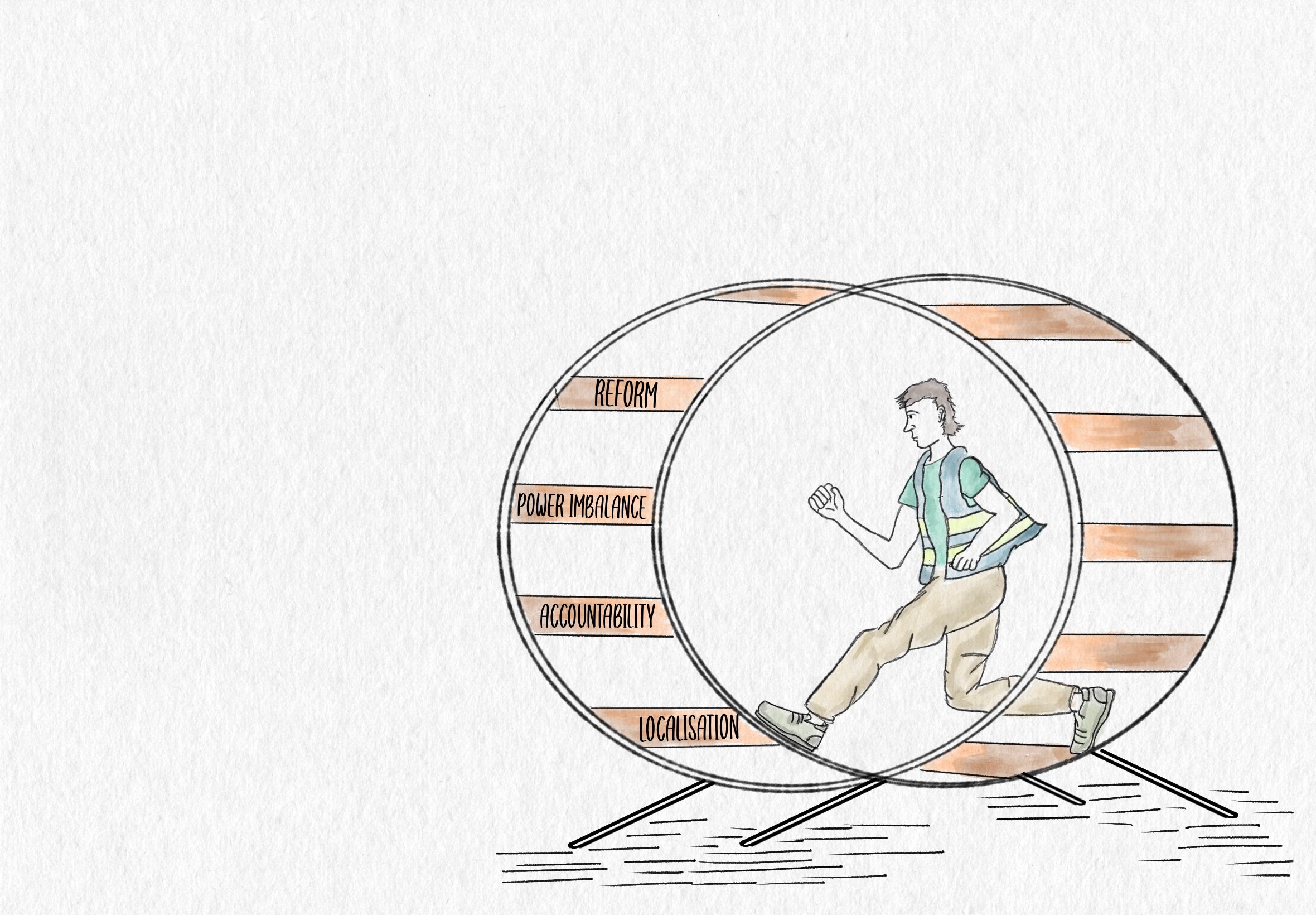In the early-2000s, at the start of my career, I evaluated a number of humanitarian operations. The assignments offered a window into the mechanics of aid and the persistent problems it faced, but also spotlighted where humanitarians were making a difference.
In one of my early jobs, I was part of a team examining the response to a major flood; tens of thousands of people had been displaced, health facilities and schools destroyed, communities were only starting to rebuild.
I sat down to interview a senior aid worker who had been part of the relief effort from the start. “Let me make your job a bit easier,” he chuckled. “Open an evaluation of the last major humanitarian disaster, do a find-all-replace with this flood, and you’ll pretty much have your report written.”
A hardened relief professional with a typically jaded sense of humour, he was, of course, joking. But I had worked as an evaluator long enough to understand what he meant: Despite contexts and crises being different, humanitarian responses – both their successes and shortcomings – followed a similar, sometimes seemingly identical playbook.
When the time came to write the report, he was largely right. None of the findings nor recommendations were all that new. Aid workers already knew the problems and their potential solutions – they were well documented in previous evaluations, hashed out in workshops with elaborate frameworks drawn up to address them.
With all this awareness of what was wrong, with repeated recommendations for how to solve recurrent problems, I’ve often questioned what gets in the way of progress. Does the humanitarian sector ever learn from its past?
“Findings and recommendations about localisation and accountability to affected people from 25 years ago look quite similar to those of today, exposing a deep-rooted inertia when it comes to undoing power imbalances.”
That’s something I had the opportunity to try to answer recently, while researching a paper for the UK-based humanitarian learning network, ALNAP. My co-author and I parsed hundreds of evaluation findings and recommendations of dozens of organisations operating throughout the aid system, carefully separating them by context, disaster type, and aid themes – everything from the use of cash in urban environments, to risk reduction efforts in disaster settings. We then ordered them chronologically to spot changes and developments over time.
What we found were two contradictory but unsurprising trends.
On the one hand, the nuts and bolts of what is delivered – the more technical aspects of aid – have improved. The humanitarian sector looks a lot more effective and professional than it did more than two decades ago: responders are better at setting up sanitation programmes; shelter materials have improved; aid workers have become more precise in assessing needs and coordinating their own efforts.
At the same time though, the aid system fumbles when it aims big. Despite lofty reform promises – the Transformative Agenda, the Grand Bargain and its Participation Revolution, and other pledges to make aid more locally owned – commitments largely go unrealised. Instead of progress, the analysis reveals a humanitarian hamster wheel: Findings and recommendations about localisation and accountability to affected people from 25 years ago look quite similar to those of today, exposing a deep-rooted inertia when it comes to undoing power imbalances.
You can hear this frustration among aid professionals in the tone of questions at aid system conferences, the sighs when confronted with these same problems again and again.
So if everyone in the room is nodding that the system needs reorientation, what’s holding it back from getting it right?
Perhaps it’s time for the sector to take a new approach: press pause on ambitious, expensive, transformational system-wide change efforts that have had limited success. Instead, let’s acknowledge that less ambitious but more focused and technical attempts at change have been successful. Taken together, these bite-sized, practical shifts may start to dislodge the underlying problems that have long beset the sector.
Localisation and accountability déjà vu
Interestingly, the language used in 25 years of humanitarian lessons papers reflects an evolution. The word “beneficiary”, a term once used to refer to recipients of aid, has been largely phased out of the humanitarian lexicon as it is considered demeaning, discounting affected people’s agency and the active role they play in aid response. In an early lessons paper from 2005, the term appears 20 times; by 2020, the word isn’t to be found.
Phrases like “the poor”, “poor people”, or “the needy” are liberally sprinkled in papers from the early 2000s. In a paper from 2021, however, there is no mention of this phrasing. This shift matters: Language offers insights into hierarchies and reflects how humanitarians perceive their role and the underlying power imbalances in aid.
Despite terminology catching up with the times, aid’s practices have not.
Take accountability. The importance of engaging communities and improving accountability to affected people has been a staple of humanitarian response evaluations since the 1996 Joint Evaluation of Emergency Assistance to Rwanda. Numerous initiatives have since attempted to close the accountability gap, so it comes as no surprise that this area is highlighted in lessons transcending aid sector type and disaster.
“Despite terminology catching up with the times, aid’s practices have not.”
But the persistence of lessons over time, despite fresh initiatives, indicates that this is also an area that the sector just can’t get right.
As someone who worked as an “accountability officer” with a large international NGO in the response to the 2010 Haiti earthquake, I understand this struggle. I, with a dozen or so Haitian colleagues, spent most of my days listening to people the organisation was meant to be serving, trying to understand their most pressing needs and priorities for assistance: education for their children; safety in the tent camps where they were now living; hope for the future.
But when these ideas were presented back to senior management, they had different plans and other constituents to please: institutional commitments; demands from headquarters; and donor priorities. It meant, for example, that instead of rebuilding a school – which the community had requested – the organisation built a psychosocial centre for kids. I’ll often read contemporary reports mimicking my experience from over 12 years ago, dismayed at just how similar today’s situation is.
Engage, and listen, to improve
Whether it’s in response to a flood or an earthquake, in settings of urban displacement or drought, as part of a shelter or sanitation project, or a way to improve coordination – evaluations over the years repeat a plain message: Humanitarians need to do a better job of engaging with affected people.
Involve the affected communities
Local capacity exists and should be involved in any humanitarian response. It should be obvious, but the message has not stuck – lessons starting in 1996 to 2019 repeat this finding again and again.
Start small and build from there
Amid glacial progress, aid observers have noted that large-scale reforms may have reached their limits in terms of bringing real change to the humanitarian system. And some argue that without addressing the underlying structures on which the aid system was founded, this stagnation of reform is likely to continue.
But past attempts at major reform have only gone so far, and all the evidence suggests that an overhaul of this nature seems unlikely in the near term.
So while the necessary goals of achieving a more equal voice and ending power imbalances seem like they demand a grandiose structural overhaul – signed up to and monitored by the great and the good – perhaps aid reformers would be wiser to try a different tack: An aggregation of smaller, more technical solutions may be the best way to scratch away at the fundamental imbalances; the best option the sector has right now for working towards the change it needs.
Some organisations are already doing just that: giving unconditional cash grants to affected people; ensuring that local organisations have flexibility and autonomy to spend money as they see fit in their community; yielding leadership seats on country-level coordination bodies to local groups.
These efforts may be confined to a handful of responders, a few innovative leaders, a small group of donors willing to fund differently. But over time, across the disasters and crises of the future, they may start to tip the balance towards putting people and local groups at the centre.
Edited by Irwin Loy and Andrew Gully.





